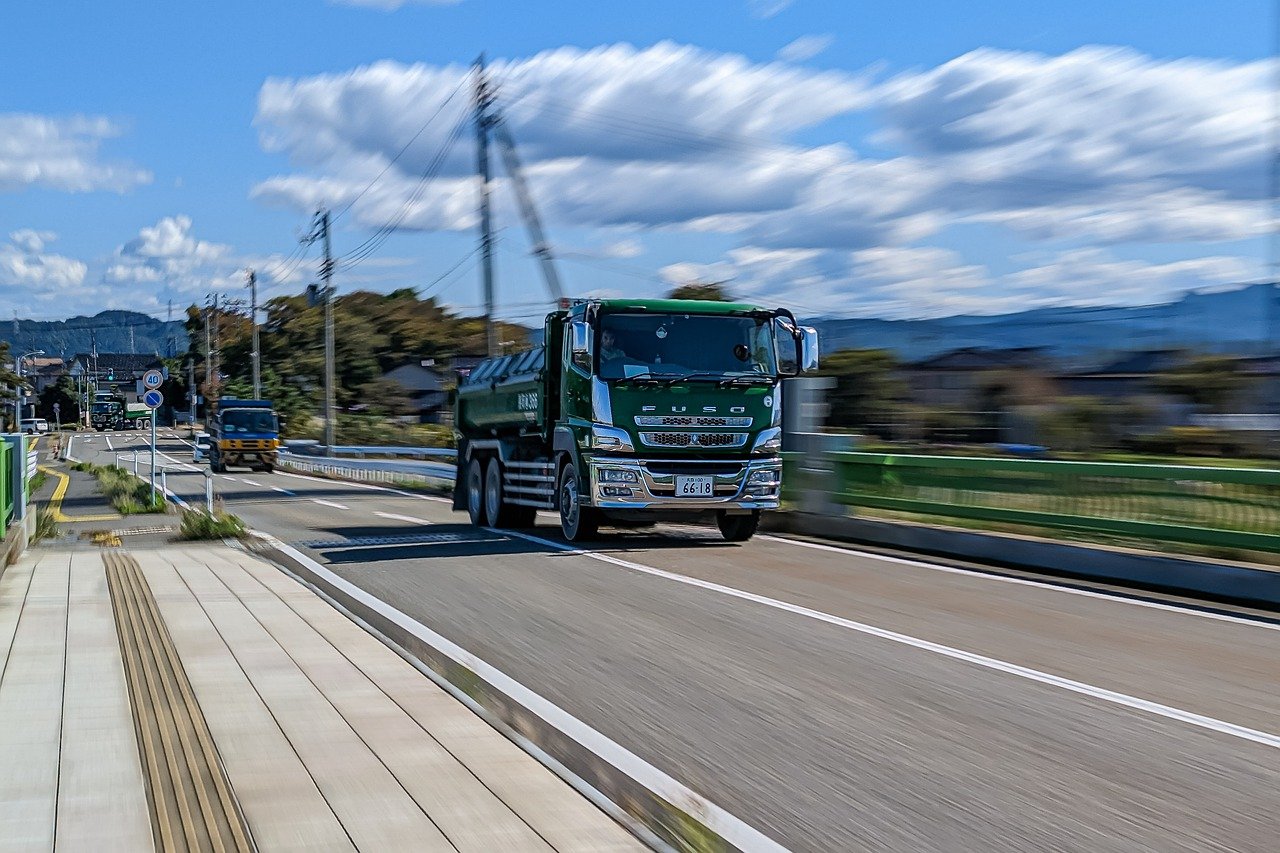

Insights
Mfg 2024.09.25
Why Operational Efficiency and Sustainability Aren’t Competing Interests
Making more money and making the world a better place are often framed as a tradeoff.
But a better way to think about it is that production issues and carbon emissions are just different ways to measure inefficiency. When you work towards solving one metric, the other usually improves.
That’s why we offer Continuous Improvement and Product Carbon Footprint (PCF) solutions. Because they naturally work in sync.
Better performance uses less energy
Put simply, better performance leads to less waste. Less waste means each finished product takes less energy to produce.
Our Continuous Improvement software is usually used to improve three key metrics: better quality, less downtime, and faster problem solving.
Improved quality means less out-of-tolerance product is produced. When an out-of-tolerance end product is thrown out, the carbon price of its inputs is spread out through your good products, increasing their carbon footprint. When more of your inputs are going into products you can actually sell, the lower each of their individual PCFs will be.
Less downtime means your factory runs more efficiently. All that time your line is down, you’re still keeping the lights on and running other machines. Energy is a major component of a PCF. When your line runs efficiently, your energy input per product drops.
Faster problem solving can affect your PCF in a few ways. A shorter feedback loop means an issue on a line can be fixed before it has cranked out hundreds of poor quality products. Visibility into temperature fluctuations means you can quickly mend a loose oven cover - improving quality and reducing wasted energy. Shift-to-shift variation can be identified and rectified, with similarly green results.
This all also works in reverse. Each of these examples could be a key recommendation that emerges from a Product Carbon Footprint consulting engagement.
Same datasets, different calculations
The beautiful thing about the overlap between operational efficiency and sustainability is that they use very similar datasets.
Throughput, availability, and quality are the cornerstones of OEE, and they all impact the energy used to make a product.
PCF’s laser focus on the inputs you use to make your product can be used as a forcing mechanism to find ways to decrease their amount and their cost.
Once you have a functioning data pipeline from your factory floor to your manufacturing operations platform, the possibilities for what you can improve begin to look endless.
What’s this mean for me?
You can use sustainability goals to drive operational efficiency. Or vice versa.
And the overlap in datasets means if you have one data acquisition solution that can do both kinds of calculations, you’re in great shape.
Most customers come to us with a pressing need for either an operational or sustainability solution. But the symbiotic relationship between the two means it's easy to apply the other solution to the same factory or product.
So why not handle both at the same time? Get carbon compliant and a lot more efficient, all at the same time. Set up a time to chat with one of our experts and we can see if it can work for your unique process.

Mfg 2024.09.23
How the 4M Method Can Improve Your Manufacturing Operations
Trying to find the root cause of production issues can be overwhelming. Modern manufacturing is a complex mechanism made up of elements that unpredictably impact each other.
Many leading operations managers use the 4M Method to organize their challenges into discrete, solvable pieces. In doing so, they make prioritizing and solving those problems much simpler.
The 4M Method can also make implementing lean manufacturing concepts like Continuous Improvement much easier and more effective.
Ready to learn more, and find out what’s up with the fish in the image? Let’s dive in.
Origins of the 4M Method
The 4M Method, much like Continuous Improvement, has its roots in Japanese manufacturing and organization theory.
Kaoru Ishikawa was a professor at Tokyo University who translated and taught the concepts of American management theorists like W. Edwards Deming (a founder of Continuous Improvement thinking) and Joseph Juran.
Ishikawa wanted to determine how to apply continuous improvement to processes when all variables are known. The result was the fishbone diagram (initially composed of 6Ms) shown below, out of which the 4M Method emerged.
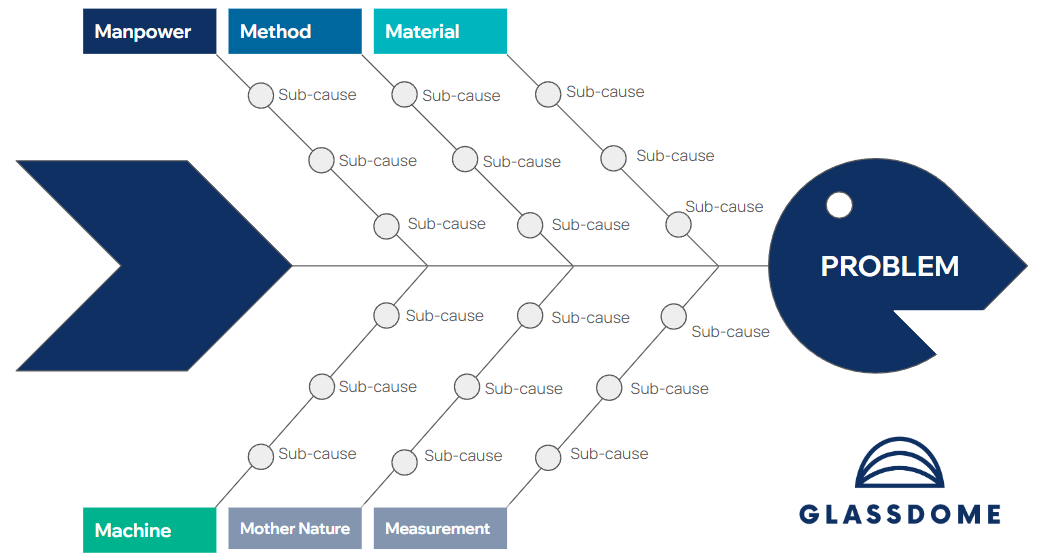
What is the 4M Method?
The 4M Method is a way to identify and group the causes of a specific problem or effect in a manufacturing process. The four factors most manufacturers use are Manpower, Method, Material, and Machine.
Manpower
This M is about all things people - skills, operations, and resources. Common issues grouped under Man include: Lack of skills, missing qualifications, inadequate training, poor habits and behavior, and lack of motivation.
To apply the Manpower factor (yes, it sounds like a deodorant brand) to current performance, companies should:
- Organize training opportunities to improve employees’ qualifications and skills.
- Define the capabilities of each employee, identify their strengths and weaknesses, and ensure they are in the best position to succeed
To apply the Manpower factor to the future, companies should:
- Rigorously define job goals and performance indicators
- Invest in recruiting the best team members in both ability and attitude, whether through pay or other benefits
The ultimate question we need to answer is: Do my employees have the skill and the will to do what is expected of them safely, consistently and effectively?
Method
Method means the way you do things - processes, schedules, and procedures. Common issues grouped under Method include: Inadequate procedures, instructions, specifications, or responsibilities, incorrect process definitions, or not applying best production practices
To apply the Method factor to current performance, companies should:
- Create a clear production strategy with public goals and metrics, and identify tasks that will help achieve those goals
- Make sure each employee and department has tasks that match their skills and goals
- Use a software solution for visibility, analysis, and informed decision making
To apply the Method factor to the future, companies should:
- Review the percentage of errors (whether that is reflected in quality or production amount) when they apply their methods
- Ensure their security is top-notch
- Build charts and dashboard to track progress (Glassdome’s CI solution is great at creating custom dashboards)
- Review instructions for machine operation, and place them where employees can easily review them
The ultimate question we need to answer is: Do I have the processes in place to produce my products consistently and safely?
One real life example: A Glassdome confectionary client measured quality by pulling snacks off of the conveyor belt by hand, measuring them with calipers, writing down the information, and handing the completed sheet to operations staff at the end of the day.
If there was a machine fault, hundreds of out-of-tolerance snacks could be produced before the problem was spotted and fixed.
By installing the Glassdome CI solution and automating the method with real-time data collection, the quality issues were dramatically reduced.
Once the Glassdome CI solution was installed, the quality control measurer was reassigned to manage machines.
In this case, a Method fix helped resolve Machine faults quickly, and optimized Manpower. The 4Ms are all interconnected.
Material
Material means the inputs in your process - information, raw materials and consumables. Common issues grouped under Material include: Poor quality of raw materials, defective components from suppliers, poor storage conditions, sourcing delays or excess
To apply the Material factor to current performance, companies should:
- Rigorously review exactly how many materials they need in their production process
- Check how materials and inventories are handled
- Invest in technology that allows real-time review on quantities and conditions in warehouses
To apply the Material factor to the future, companies should:
- Create or automate a process to check incoming material quality
- Apply just-in-time manufacturing concepts to reduce the amount of raw materials and finished products that need to be stored for long periods of time
- Develop a supplier management system to consistently re-evaluate the caliber of your suppliers
The ultimate question we need to answer is: Do my materials meet my needs? Are there no defects or shortages? Are they being handled or moved too much? Are they stored in the right conditions?
Machine
Machine is simple. It means the equipment you use to make your products. Common issues grouped under Machine include: Inadequate care, cleaning, and inspection, inadequate or aging machines, or poor installation
To apply the Machine factor to current performance, companies should:
- Create a comprehensive maintenance plan that works with your production schedule
- Implement software that helps you see and solve issues with machine maintenance and help you predict over- or under-use of your machines
- Invest in modern machinery. It’s expensive, but just like trading in a creaky lemon for a new car it can be worth it over the long run
To apply the Machine factor to the future, companies should:
- Review their maintenance schedules and results
- Review how machines are arranged on the floor and how and when they’re used for maximum efficiency
- Check that employees are properly assigned to machines based on their skills, and how many operators the machine needs
The ultimate question we need to answer is: Are my machines capable of sale and reliable output at the quality and rate I want? Are breakdowns, defects, or unplanned downtime getting in the way of that goal?
How can I use the 4M Method? And how can Glassdome help?
By prioritizing your issues through the 4M method, you can turn an ominous cloud of problems into a structured plan full of solutions. Making continuous improvement a lot more manageable.
Continuous Improvement is all about making big improvements over time through frequent small wins. It’s a natural fit with the 4M Method’s emphasis on prioritization and visibility.
It can start with a simple checklist like the one below.
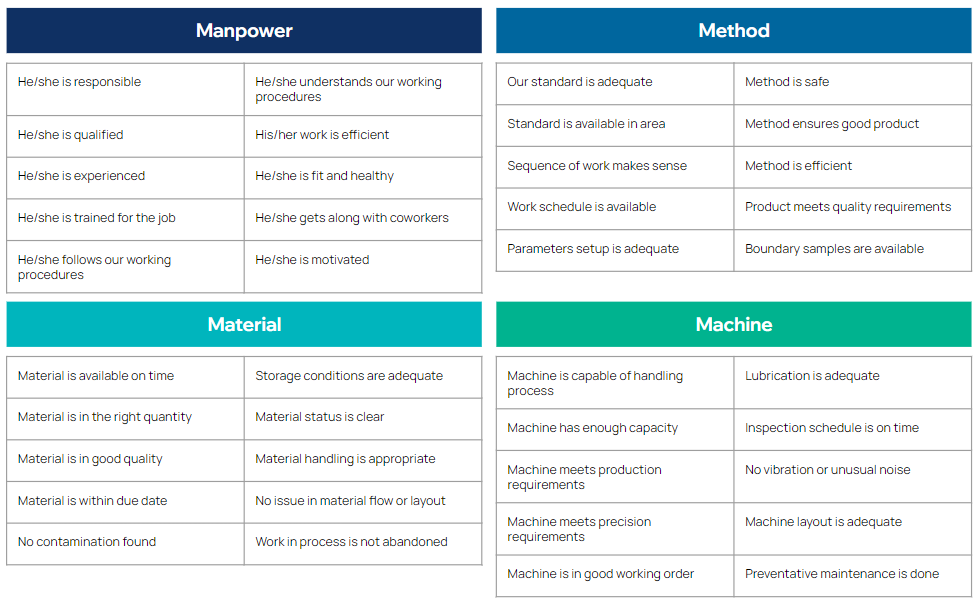
Both methodologies only work to their highest potential if you can see and analyze what’s actually happening on your factory floor. That’s where Glassdome’s real-data-based Continuous Improvement solution comes in. By seeing real machine, shift, and production data in real time, you can make informed decisions that lead to big improvements.
You’ll cut downtime, increase quality, and solve problems faster.
Sound appealing? Get in touch with one of Glassdome’s manufacturing experts to learn more.
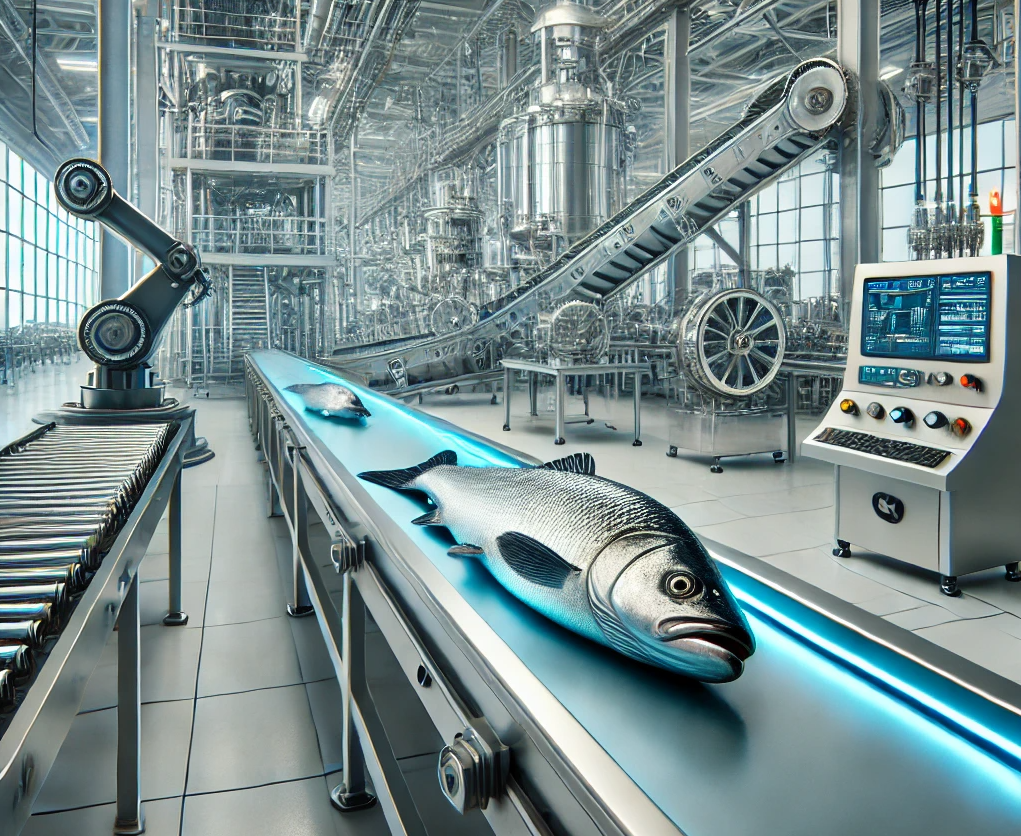
News 2024.09.17
Glassdome and LG Electronics Launch Product Carbon Footprint Calculation and ISO 14067 Verification Project
Glassdome's SaaS-based solution will help LG Electronics use real-data-based metrics to simplify carbon verification and compliance
Vancouver, Wash. and Seoul, South Korea: Glassdome , a leading industrial software company, is proud to announce the launch of a new Product Carbon Footprint calculation and ISO 14067 verification project with the LG Electronics Vehicle component Solutions (VS) Company .
LG VS Company develops and creates vehicle displays, connectivity solutions, and infotainment systems. It has also recently expanded into vehicle lighting systems and cybersecurity. LG's solutions are a key technology for the future of mobility as electric vehicles displace traditional powertrains around the world.
The global auto industry aims to be carbon neutral by 2050. To fulfill that goal, automakers are demanding that their suppliers calculate the Product Carbon Footprint (PCF) of their components, and get a third-party to verify that those numbers are accurate.
LG VS Company is making sure it stays compliant and competitive with the real-data-based Glassdome Product Carbon Footprint solution . Glassdome is a SaaS-based platform developed in accordance with ISO standards that derives real data from machines on the factory floor and securely integrates data from Tier 2 and 3 suppliers.
It provides complete, consulting-backed support for carbon emission data collection, monitoring, and reporting throughout the manufacturing process.
In March, Glassdome achieved ISO 14067 certification from Lloyd's Register Quality Assurance , a global certification body. This streamlines the PCF verification process for customers by ensuring that the reports they create with Glassdome already match the highest international standards.
The Glassdome platform also speeds up the process by ensuring trust from the entire supply chain. Many of the required data inputs in PCF calculations could be used to derive sensitive data like component recipes and unit cost to produce. The Glassdome platform holds that data in a secure cloud, converts it into carbon emissions data, and only transmits those relevant outputs.
“The Glassdome solution solves carbon emission management issues facing global manufacturers as they respond to global regulations, and supports easy ESG transformation for companies,” commented Jinki Ham, Chief Business Officer of Glassdome. “Glassdome will help exporters strengthen their competitiveness in the market with our proven consulting and technology and fast and reliable third-party verification support.”
About Glassdome: Glassdome is an industrial software company with expertise in acquiring and analyzing data from manufacturing equipment. Glassdome's SaaS-based solution guides manufacturers from data collection to monitoring to ongoing reporting, enabling them to obtain data from machines, transfer it to software, and access it. The company empowers manufacturers within the EV battery, automotive, chemical, pharmaceutical, and food and beverage industries to capture the untapped potential of data throughout the supply chain to achieve continuous operational efficiency improvement and meet regulatory environmental and emissions compliance.
For more information, contact John Wright, Director of Global Marketing, at john@glassdome.com.
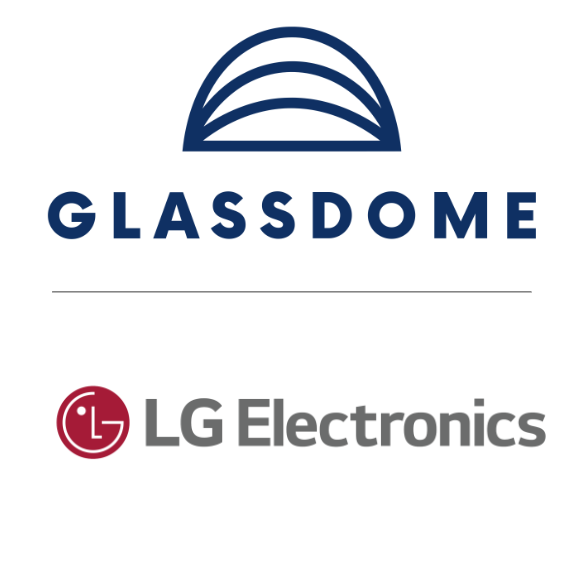
PCF 2024.09.05
EU Battery Regulation: Timeline and System Boundary Requirements
EU Battery Regulation 2023/1542 is a gamechanger for battery makers importing to the EU and the companies they supply.
We’ve covered what these regulations mean for battery manufacturers in depth in a previous Insight.
In this Insight, we want to focus on the timeline. What do battery manufacturers need to act on for the near term, and what do they need to plan for in the long term?
EU Battery Regulation Overview
Before we start, let’s quickly review what EU Battery Regulation 2023/1542 entails:
Objective:
The EU Battery Regulation aims to ensure that batteries placed on the European market are sustainable and safe throughout their life cycle, covering all actors and their activities.
Who is impacted by the EU Battery Regulation?
The Regulation applies to any battery in the EU market with a capacity over 2kWh
What is required?
Article 7, together with Annex II, dictates required carbon footprints of electric vehicle batteries and rechargeable industrial batteries.
When does it start?
The regulation begins to come into force a year from the passage of its implementing act - likely sometime in 2025.
When do I need my Product Carbon Footprint? How about a digital battery passport?
 You need to start with a real-data-based Product Carbon Footprint.
You need to start with a real-data-based Product Carbon Footprint.
The EU requires the carbon footprint of every EV battery sold in the EU be calculated and made publicly accessible by February 2025. Industrial batteries over 2kWh get an extra year - their deadline is in 2026.
The information in the footprint must be specific to each model and manufacturing plant and collected throughout the value chain. Any changes to materials or facility-level energy mix must be reflected, and carbon offsets cannot be included in the calculation. This will be used by the EU to help sort EV batteries into similar-performing types for easy identification in the future.
For the 2025 and 2026 deadlines, the Product Carbon Footprint just needs to include active material production. This system boundary, from raw materials to the finished product leaving the factory, is often called Cradle to Gate.
In the medium term, you’ll need to start engaging your suppliers and partners. In 2027, the system boundary requirements will expand to cover the four main stages of the battery life cycle:
- Mineral extraction and pre-processing
- Battery manufacturing (inclusive of active materials, cell manufacturing, and battery pack assembly)
- Distribution
- End-of-life processing and recycling
This full-lifecycle view is called Cradle to Grave.
Check out the infographics below for complete system boundary information.
For EV Batteries:
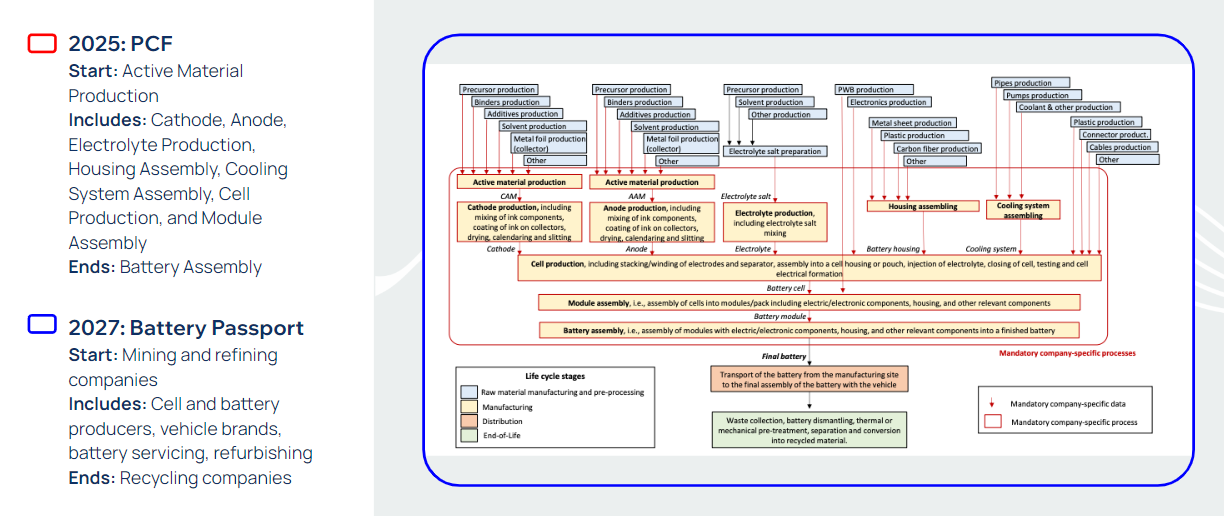 For Industrial Batteries:
For Industrial Batteries:
 Also in 2027, that data will need to be stored in a publicly available Digital Battery Passport. The idea behind the gap is to give companies time to iron out the process before the repercussions for failure get more serious.
Also in 2027, that data will need to be stored in a publicly available Digital Battery Passport. The idea behind the gap is to give companies time to iron out the process before the repercussions for failure get more serious.
(Already thinking about how much work that plant-level, real data-based PCF is going to be to calculate? Glassdome can help. Our PCF platform makes Battery Regulation compliance simple.)
Where should I start?
You should have all of the digital and organizational infrastructure in place to respond as soon as the implementing act is a go.
The most immediate need is a Product Carbon Footprint for each EV and industrial battery you produce. Then you can incorporate that PCF into a Digital Battery Passport.
Step 1: Calculate your PCF
As you can probably gather from the diagrams above, PCF calculation can be incredibly tedious and time-consuming. Setting your system boundaries, poring through dense databases, making sure you’re complying with reams of certification and legal regulations. Glassdome’s PCF solution helps manufacturers simplify PCF calculation and reporting.
Step 2: Verify your PCF
Not just any PCF report will do when you’re trying to comply with regulations. You need to create a report that complies with international standards to achieve your business needs. Glassdome’s PCF solution is ISO 14067 verified by LRQA. That means you’ll be able to get the PCF report you create with Glassdome verified quickly and easily compared to competitor solutions.
Step 3: Publish your PCF
Create a publicly available platform for regulators and customers to view your PCF. Our consultants can help ensure you’re complying with EU regulations.
Step 4: Create your Digital Battery Passport
With a compliant PCF in place, you have a couple of years to build the infrastructure of a digital battery passport for all of your battery models. Glassdome’s plant and product level data makes acquiring real data across multiple models a snap.
Want to learn more? Get in touch with a Glassdome sustainability expert today. Through our work with organizations like Samsung SDI, the Global Battery Alliance, and LG Electronics, we know how to help the world’s leading battery makers prepare for this regulation.

PCF 2024.08.22
What is the Global Battery Alliance Digital Battery Passport? (And How is Glassdome Involved?)
Glassdome exists to work with manufacturers to help build a more abundant future. Few projects exemplify our vision like the Global Battery Alliance Digital Battery Passport program.
The GBA was established at the World Economic Forum in 2017 through cooperation between battery producers, mining and energy companies, and government agencies. The Digital Battery Passport initiative helps it achieve its goal of a carbon neutral battery value chain by 2050.
Glassdome is leading a pilot program for the GBA. We’re bringing together 13 global companies and organizations to get ready for the EU Battery Directive’s implementation while advancing the GBA’s other goals.
How exactly does the project work, and how will it move both of our visions forward? Read on to find out.
The GBA Digital Battery Passport
The Digital Battery Passport is a system that tracks, manages, and provides access to full lifecycle and sustainability data for EV and industrial batteries over 2kWh distributed in the EU. To comply, battery manufacturers and suppliers need to collect and manage key data like their product carbon footprint (PCF), percentage of recycled materials, and country of origin.
The EU Battery Directive requires the implementation of a battery passport by February 2027. The EU requires that the battery passport contains:
- A unique identifier
- The type of model of the battery
- Performance and durability statistics, updated over the battery’s lifecycle by those who repair or repurpose the battery
The GBA pilot program takes it a step further. The GBA passport, accessible via a QR code on the battery itself, will include:
Labeling data
Information necessary for identification of a specific battery and its components
Technical data
Technical parameters of a battery model and particular battery
Usage data
Information related to events during the battery’s use
Sustainability data
Sustainability performance expectations for the battery
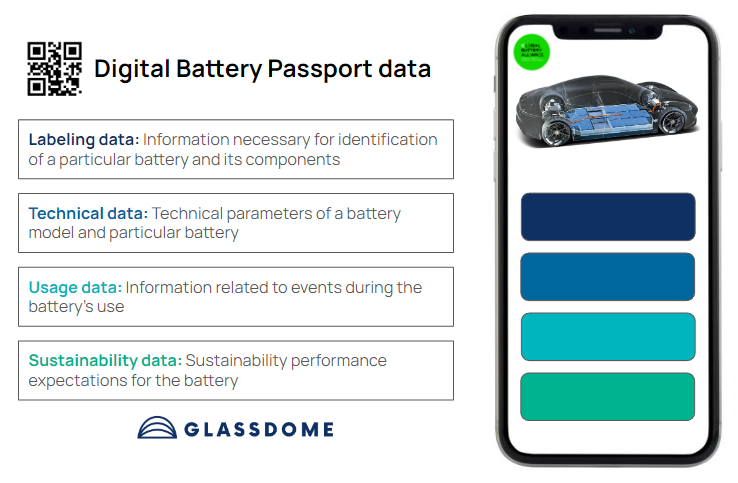
What ESG indicators does the GBA Digital Battery Passport program cover?
The GBA goes several steps further than the EU when it comes to economic, social, and governance indicators.
The GBA Digital Battery Passport process will cover twenty one ESG indicators, whose frameworks are in varying degrees of completion.
Indicators marked in green have existing coverage in existing rulebooks or drafts.
Indicators marked in blue correspond to risk categories in the EU battery regulation due diligence chapter.
Indicators marked in black are remaining salient ESG issues.

What is Glassdome’s role?
Glassdome is project managing the pilot, storing the PCF data in our secure central hub, and helping companies in the pilot program navigate and learn from the initiative. We’re also acting as an expert guide that knows the details of battery passport regulation front-to-back.
Wrangling data from thirteen companies and organizations involved isn't easy, but our background in secure data management and sustainability metric calculation for global enterprises make us well-suited for this role.
The members of this program are:
- Glassdome
- Samsung SDI (battery manufacturer)
- SKIET (separator)
- EcoPro (cathode material)
- SK Nexilis (copper foil)
- Lotte Infracell (aluminum foil)
- Choil Aluminum (aluminum foil)
- Inzi Controls (battery module manufacturer)
- SK tes (waste battery recycler)
- PM Grow (battery subscription service and reusable battery company)
- Future Battery Industries Cooperative Research Centre (Australian battery research center)
- Korea Battery Industry Association (Korean battery trade association)
- SK C&C (digital carbon passport platform company)
How can Glassdome help your company?
Are you a battery manufacturer or supplier that needs to comply with the EU Battery Directive, or wants to get ready by joining in with the GBA pilot projects?
You’re going to need to start with a Product Carbon Footprint. Glassdome’s real data-based Product Carbon Footprint solution is made for manufacturers and suppliers. It simplifies carbon compliance, with integrated data aggregation and calculation and automated reporting.
Sound interesting? Get in touch and one of our experts can help you find the best climate compliance solution for your business.

PCF 2024.08.19
What is ISO 14067 and why is it important for my business?
If you work at the intersection of manufacturing and sustainability, you’ve probably heard about ISO 14067.
Whether you’re an automotive supplier whose OEM is asking for verified product carbon footprint data, a consumer tech company whose customers are getting suspicious of greenwashing, or a company that wants to do right by the environment, it’s something you need to know about.
At Glassdome, we’re proud to say our Product Carbon Footprint solution is ISO 14067 verified.
That’s why we’ve put together everything you need to know about ISO 14067 and why it matters to your business.
What is ISO 14067?
Let’s start with the basics. ISO stands for the International Organization for Standardization. As they succinctly put it, ISO “brings global experts together to agree on the best way of doing things.”
If a product or process is verified by ISO, it’s made in a way that holds up to the highest global standards.
The ISO 14067 standard codifies the principles, requirements, and guidelines for quantifying and reporting a product carbon footprint (PCF) (also known as a CFP, or carbon footprint of a product). It addresses only a product’s impact on climate change, excluding other social, economic, and environmental factors.
This standard is consistent with two international life cycle assessment (LCA) standards:
ISO 14040: LCA principles and framework
ISO 14044: LCA requirements and guidelines
But while an LCA covers climate change (carbon emissions), water, ozone, acidification, land use, and more, a PCF only looks at climate change impact measured through the carbon emissions created in the production of a product.
A similar, but not quite identical standard is ISO 14064, which covers an organization’s scope 1, 2, and 3 emissions, and is consistent with the GHG Protocol. Useful, but not a PCF.
ISO 14067 isn’t just important for corporate sustainability. It also aligns with UN Sustainable Development Goal 13 on Climate Action. Companies that follow it are helping to foster a better world for everyone.
What does ISO 14067 do for my business?
Getting an ISO 14067 verified PCF has a broad array of benefits for your business. They can include:
Reliable benchmarking for organizations and consumers: PCF is the only apples-to-apples comparison tool when comparing product sustainability. Facility or corporate level data doesn’t work at the product level given the massive amount of additional variables they bring to the comparison.
Trust and transparency: Greenwashing is rampant in sustainability declarations and advertising, and consumers are catching on. A verified PCF shows you take compliance seriously, and your data and improvement are trustworthy.
Streamlined compliance: As you’ll see below, by conducting your PCF calculation with a verified solution, you can cut down the time to comply with regulations from the EU, California, and others by weeks or months.
Improved efficiency: Once you know your PCF, you’ll know how to improve it. And happily for your bottom line, one of the best ways to do it is to increase efficiency. Sustainability improvement can go hand in hand with continuous improvement efforts in your facilities.
Strong sustainability foundation: Sustainability standards rarely live on their own. If you need to comply with standards like ISO 14001 (environmental management systems) or ISO 14025 (environmental labels), you need to start with a verified first step.
What does Glassdome’s ISO 14067 verification mean for me?
Like we said in the introduction, the Glassdome Product Carbon Footprint solution is ISO 14067 verified. But what’s that mean for your business specifically?
If your business deals with global environmental regulations like EU CBAM, California SB 253, or the Digital Battery Passport, you’ll enjoy a far simpler third-party verification process. Carbon emissions that are measured and reported through our platform will be ISO 14067 compliant by default. That cuts time, cost, and red tape.
And that is about to become very important. Emissions reporting for CBAM will be required by 2025. And once it’s implemented in 2026, third-party verification will be required. Also, Article 47 of the new EU Battery Regulation means many battery makers need to have verified PCFs sooner rather than later.
Third-party verification can take up to three months, and the cost can be quite high. By dramatically cutting the time to produce the report with our automated system, sometimes to as low as two days, and using a verified solution that knows exactly what verifiers need, you can sail through regulations with comparative ease.
What’s next?
Does an ISO 14067 verified PCF like something that your business might need? Just want to know more about how these regulations could impact your business? Drop us a line.
Get the true picture of the carbon footprint of your products. Before you customers demand it and you’re snarled in red tape.

Mfg 2024.07.31
What is Continuous Improvement in Manufacturing?
When it comes to manufacturing, continuous improvement means more than simply making things better. It’s an organization-wide approach to driving major change through incremental improvements. When they adopt a continuous improvement approach, organizations take established processes, break them into manageable components, and make consistent incremental improvements.
It’s a methodology born from manufacturing and designed to increase productivity and efficiency, reduce waste, and improve employee engagement and customer satisfaction. And it’s holistic: it affects everything from C-suite decision-making to company culture on the factory floor.
It’s much easier to implement continuous improvement when you work with a software partner that knows how to get your manufacturing data and turn it into the reports and analytics you need. That’s what Glassdome does.
What are the key principles of Continuous Improvement?
Continuous improvement is based on five core ideas:
Most improvement comes from small changes, not total revolution: Continuous improvement is in some ways a broad implementation of the saying “don’t let perfect be the enemy of good.” Any idea, no matter how small, to reduce time-to-market, cut defects, or reduce waste is a good one.
Bottom-up change is as valuable as top-down: A culture of continuous improvement means that input from the factory floor, whether from employees or machines, is key to identifying and implementing useful changes.
Improvement doesn’t need to be expensive: Many continuous improvement initiatives lead to streamlining process steps, fixing broken processes, or reducing waste. Simple changes in mindset and better data flow can actually cut costs and save money.
Improvement engages employees: By empowering and upskilling staff, manufacturers can retain and improve the staff they already have while they refine their processes.
Improvement should be measurable: You should be able to track improvement through metrics like reduced costs, lower takt time, fewer defects, or improved customer satisfaction.
What are the origins of Continuous Improvement?
Continuous Improvement is based on kaizen. Kaizen is a Japanese philosophy and professional methodology based on creating major improvements in one’s life through small daily changes.
Kaizen was adopted by manufacturers tired of large top-down initiatives crumbling in the absence of experimentation, necessary data, and team input. They found that a consistent culture of making things better helped make changes stickier and less risky.
Major manufacturing leaders like W. Edwards Deming and Taiichi Ohno (we’ll come back to him later) codified the continuous improvement approach in methodologies like Total Quality Management and Lean Manufacturing.
Why do manufacturers need Continuous Improvement?
Manufacturing companies around the world face enormous challenges, from labor shortages, to rising input costs, to aging equipment. By implementing a continuous improvement plan, manufacturers can make themselves more adaptable, efficient, and profitable.
Continuous improvement strategies can solve multiple challenges at once. These include:
- Improving quality
- Cutting down on waste
- Lowering operating costs
- Increasing workplace safety
- Enhancing efficiency
- Increasing employee productivity & buy-in
- Reducing staff turnover
- Enhancing agility
The world continues to change rapidly. The adaptability and resilience built into companies with a culture of continuous improvement helps ensure that they don’t get caught flat footed. While competitors stall and flounder, they can quickly start evolving.
How does Continuous Improvement connect to Lean Manufacturing?
Continuous improvement approach means getting better each day through small-scale refinements and adaptations built on bottom-up input and data. Lean manufacturing is a systemic approach to increasing efficiency and cutting waste through empowering employees and streamlining processes.
While the two are subtly different, they are naturally symbiotic. A culture of continuous improvement makes lean manufacturing work better.
Lean manufacturing has its origins in the automotive industry, with Henry Ford’s assembly line and the Toyota Production System developed by Taiichi Ohno. But the lean approach can be adopted by any manufacturer.
Lean manufacturing is built around a four-part cycle: Plan, Do, Study, Adjust. Through consistent use of this cycle, lasting changes are built and strengthened.
In that cycle, lean organizations are guided by five principles (defined in the book Lean Thinking by James Womack and Daniel Jones):
Identify Value: Understand what customers want and are willing to pay for. Deliver products and services that meet those needs in the least wasteful way possible.
Map the Value Stream: Identify and codify every step and process involved in creating and delivering your products or services. Include any delays that happen between those steps.
Create Flow: Remap the value stream to channel a smooth flow of work, focusing on the handoffs between teams and departments. Cut down on interruptions, delays, and bottlenecks to increase efficiency.
Establish Pull: Adopt a system where customer demand drives (pulls) production and material movement. By producing only what customers need when they need it, you avoid overproduction and excess inventory.
Seek Perfection: Cultivate a culture of reflection, continuous improvement, and empowered problem-solving. Create better processes by striving for perfection at the employee level.
Integrating continuous improvement with lean manufacturing leads to the best of both worlds. A culture of innovation and engagement with a structure for waste reduction and process improvement.
How can I implement Continuous Improvement?
Continuous improvement is an approach, a mindset, and a culture, built into one. The fact that it’s not one-size-fits-all makes it adaptable, but it can also leave managers wondering where to start.
Workflow tools like Kanban, systems like 5S, and techniques like Root Cause Analysis can all be helpful.
But all of them rely on good data. Good data is where impactful continuous improvement starts. Without accurate, timely information, quick and effective changes can’t be made.
That’s where Glassdome comes in.
The Glassdome Continuous Improvement solution gives you all of the data you need from your factory floor, in a form you can understand and use.
Our consultants come to your location and connect your machines to our IoT gateways to start acquiring process data. Our manufacturing expertise means we can even pull useful data from older machines, machines that use proprietary software, or machines that aren’t connected to the internet.
Once the data pipeline is established, we work with you to build a real-time overview of your processes, from basics like downtime and pace of production to advanced analytics like flight paths, takt time, and more.
With that information, you can improve your processes in real time. And with customizable, actionable reports, you can measure your progress month-over-month (or week, or year).
Want to start implementing a continuous improvement plan? Our staff of manufacturing experts can help. Get in touch today, and let’s have a conversation.
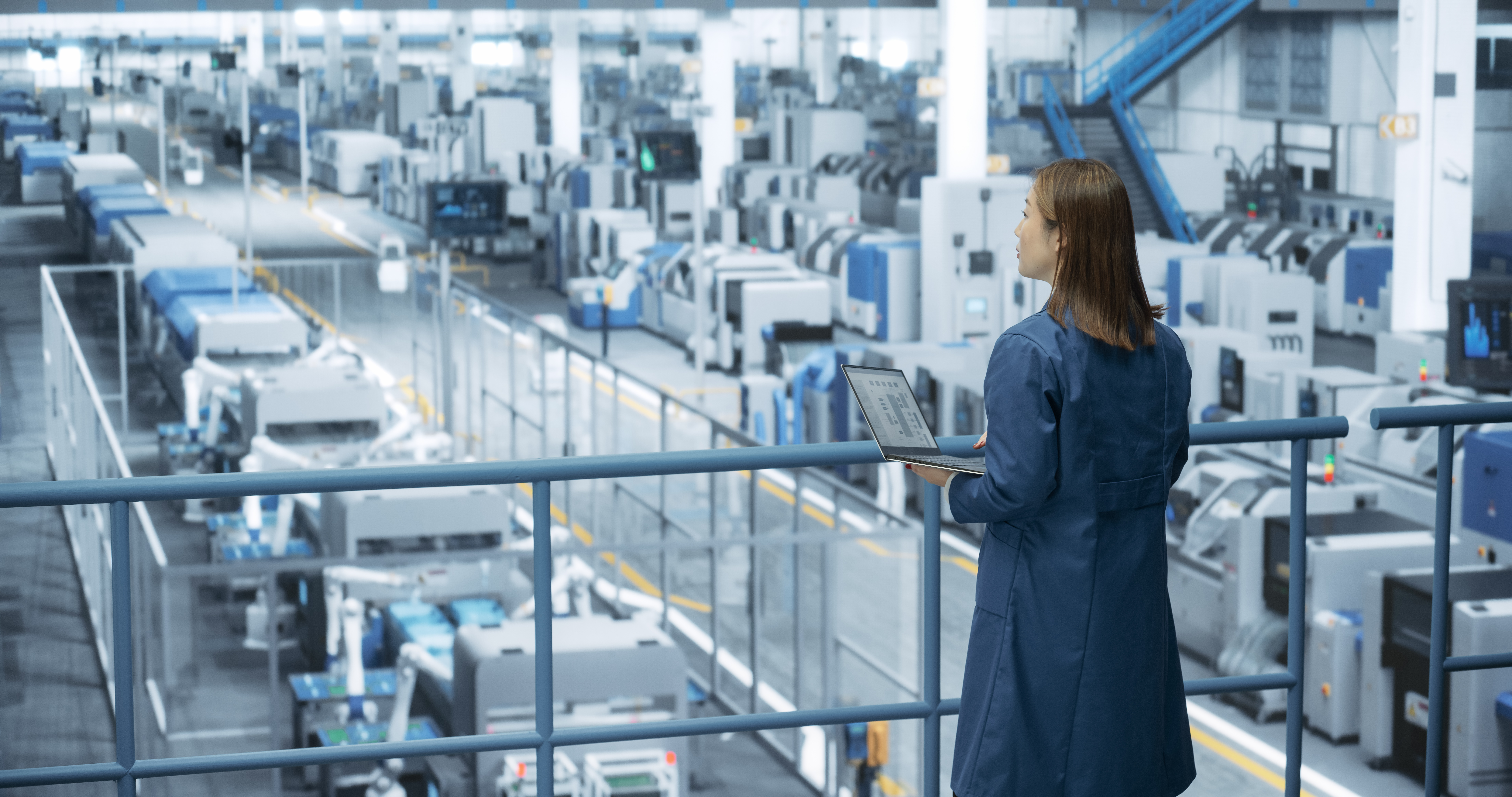
News 2024.06.03
Glassdome selected as organizer of new Global Battery Alliance Digital Battery Passport Pilot
Consortium of 13 companies, including Samsung SDI, SKIET, EcoPro, Lotte Infracell, and SK C&C, formed to respond to EU Battery Directive
Pilot project launched in May 2024 to establish systems, inspect companies’ regulatory response processes, and prepare for 2027 implementation of digital battery passport requirements
Vancouver, Wash., and Seoul, South Korea: Glassdome, a leading sustainability platform for manufacturers, was selected by the Global Battery Alliance (GBA) to organize a new Digital Battery Passport pilot project. The choice was revealed in an announcement on May 21, 2024. Glassdome has formed a consortium of 13 companies, including Samsung SDI, SK IE Technology (SKIET), EcoPro, and Lotte Infracell, and will lead a pilot program designed to preemptively respond to upcoming EU Battery Directive Digital Battery Passport requirements.
The Digital Battery Passport is a system that tracks, manages, and provides access to full lifecycle and sustainability data for EV and industrial batteries over 2kWh distributed in the EU. The EU Battery Directive requires its implementation by February 2027. To comply, battery manufacturers and suppliers need to collect and manage key data like their product carbon footprint (PCF), percentage of recycled materials, and country of origin.
The Glassdome platform helps companies report their PCF using real data. Carbon compliance and global environmental regulatory reporting are often a complex, time consuming process. Glassdome makes sustainability simple for manufacturers by guiding them from data collection to monitoring to ongoing reporting.
This year, Lloyd's Register Quality Assurance (LRQA) named Glassdome as the first ISO 14067 verified real data PCF platform. When a company measures and reports their PCF through Glassdome, its results already comply with ISO 14067 standards, shortening the verification period by weeks and cutting costs.
The GBA was established at the World Economic Forum in 2017 through cooperation between battery producers, mining and energy companies, and government agencies. The Digital Battery Passport initiative helps it achieve its goal of a carbon neutral battery value chain by 2050.
The GBA pilot project led by Glassdome will derive accurate real-data-based PCFs across the entire battery manufacturing lifecycle. It will also implement a secure data management system that helps manufacturers and partners share only their relevant PCF data, and only with those who need to know it.
The full consortium consists of:
- Glassdome
- Samsung SDI (battery manufacturer)
- SKIET (separator)
- EcoPro (cathode material)
- SK Nexilis (copper foil)
- Lotte Infracell (aluminum foil)
- Choil Aluminum (aluminum foil)
- Inzi Controls (battery module manufacturer)
- SK tes (waste battery recycler)
- PM Grow (battery subscription service and reusable battery company)
- Future Battery Industries Cooperative Research Centre (Australian battery research center)
- Korea Battery Industry Association (Korean battery trade association)
- SK C&C (digital carbon passport platform company)
Jinki Ham, CEO of Glassdome Korea, remarked, “As we transition from a linear to a circular economy, the global market needs environmental impact data. Sustainability regulation is changing the disclosure of information like recycling rates and product carbon footprint from a nice-to-have to a must-have.”
He continued, “Glassdome is a world leader in carbon regulation solutions. We’re dedicating ourselves to helping our manufacturing clients, large and small, continue to export to customers in Europe and anywhere else carbon regulation emerges.”
Lee Jeong-hoon, head of the SK C&C Net Zero Platform Business Team added, “Digital and ESG expertise based on LCA foundations is essential in tracking carbon data in the battery value chain. By combining that expertise with generative AI technology, we will go beyond simple data tracking and make our customers more competitive by helping them reduce their carbon footprints.”
Under Glassdome’s leadership, a total of 13 battery value chain companies from Korea, the U.S., and Australia will form the GBA consortium and promote the ‘Digital Battery Passport’ pilot project from May 2024.
About Glassdome: Glassdome is an industrial software company dedicated to making sustainability and operations clear and simple for manufacturers. The company was founded in the innovative heart of San Francisco in 2019. Roots in Silicon Valley and Korea connect a tech-savvy spirit with powerful industrial expertise. The Glassdome platform is uniquely positioned to serve manufacturers that want to improve efficiency and meet and exceed green regulation requirements, all in one platform.
Find out more at glassdome.com.

News 2024.03.25
Glassdome Completes the ISO 14067 International Standard Verification for Product Carbon Footprint Assessment from LRQA
• LRQA verified that Glassdome complies with ISO 14067, the international standard for calculating and reporting product carbon footprints (PCFs).
• Glassdome developed its PCF solution in accordance with the ISO 14067 standard from the outset. The Glassdome solution streamlines third-party verification, saving time and money.
• EU CBAM regulation will require third-party verification by an accredited institution for carbon emissions reporting. From 2026, verification will be mandatory to export items like steel and aluminum to the EU.
LRQA is an internationally accredited certification body and is recognized by the EU as an EU Emissions Trading System verifier. It also plans to be registered as one of the first accredited verifiers for the EU Carbon Border Adjustment Mechanism (CBAM). LRQA reviews CBAM reports, which are required to export items such as steel and aluminum to the EU, and assesses compliance with international standards. The company currently conducts international standard certification and verification in more than 160 countries.
ISO 14067 is the most prestigious international standard for PCF. It is based on the ISO 14040 and ISO 14044 standards for LCA (Life Cycle Assessment), which define the methodology for calculating and reporting carbon footprints. ISO 14067 verification means that the product carbon footprint, (carbon emitted throughout the entire lifecycle of a product) is measured and reported in compliance with the principles, requirements, and guidelines demanded by the international community.
Glassdome developed its product carbon footprint solution in accordance with ISO 14067 standards from the outset. This verification recognizes that both the method of calculating the product carbon footprint and the reports by the Glassdome solution are up to the highest international standards.
This proactive response to global environmental regulations like EU CBAM and the Digital Battery Passport means Glassdome customers will enjoy a far simpler third-party CBAM verification process. Carbon emissions measured and reported through Glassdome will automatically be ISO 14067 compliant, cutting time, cost, and red tape.
EU CBAM mandates that exporters of products like steel and aluminum to the EU must report carbon emissions produced during the manufacturing process to properly price their carbon tax. In the current transition period, measuring and reporting emissions will be required by 2025. Once CBAM is fully implemented in 2026, third-party verification of those reports by accredited bodies will be required.
Third-party verification can vary widely in time from three weeks to three months, and costs can be considerable. That makes a streamlined all-in-one solution like Glassdome an appealing solution for manufacturers.
Glassdome technology helps customers use real data to manage the life cycle of their products’ carbon footprints. Its all-in-one PCF solution supports the entire process from manufacturing data collection to monitoring and reporting, enabling compliance with environmental regulations.
Many competitors use default data from publicly available databases. Glassdome uses accurate measured data, significantly decreasing the risk of default values inflating carbon emissions and resulting in penalties or failure to get reports certified. To protect the sensitive information of manufacturing partners, the Glassdome platform analyses collected data in real time, converts it into carbon emissions values, and only transmits that data.
Lee Il-Hyung, Head of LRQA Korea, stated, "In an era when managing a company's carbon emissions for ESG management is an unstoppable global trend, Glassdome is leading the market by quickly introducing a product carbon footprint solution. Acquiring this ISO international standard verification will serve as an opportunity to internally and externally promote its technological competitiveness."
Simon Kim, CEO of Glassdome, added, "The Glassdome product carbon footprint solution significantly reduces the time and cost of the third-party verification required to export to the EU. We support companies exporting to Europe by providing accurate global carbon emission calculations and fast and reliable third-party verification, helping them secure and maintain a competitive edge in sustainability."

Subscribe
Enter your email address to subscribe to the Glassdome Sustainable Manufacturing Blog
This site is protected by reCAPTCHA and the Google
Privacy Policy and
Terms of Service apply.


